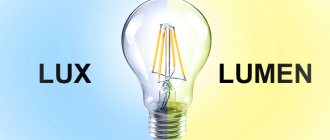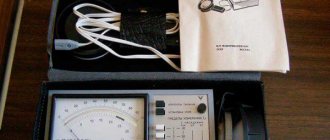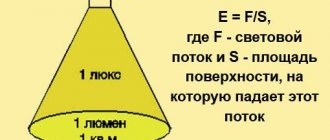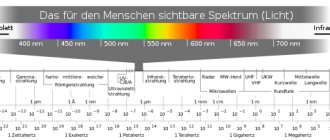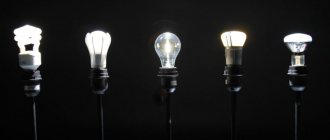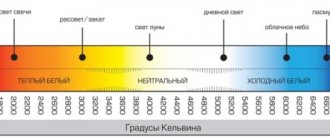General information
Illuminance is a luminous quantity that determines the amount of light falling on a certain surface area of the body. It depends on the wavelength of light, since the human eye perceives the brightness of light waves of different lengths, that is, different colors, in different ways. Illuminance is calculated separately for different wavelengths, since people perceive light with a wavelength of 550 nanometers (green), and colors that are nearby in the spectrum (yellow and orange), as the brightest. Light produced by longer or shorter wavelengths (violet, blue, red) is perceived as darker. Illumination is often associated with the concept of brightness.
Illumination is inversely proportional to the area on which the light falls. That is, when illuminating a surface with the same lamp, the illumination of a larger area will be less than the illumination of a smaller area.
Difference between brightness and illuminance
BrightnessIllumination
In Russian, the word “brightness” has two meanings. Brightness can mean a physical quantity, that is, a characteristic of luminous bodies, equal to the ratio of the intensity of light in a certain direction to the area of projection of the luminous surface onto a plane perpendicular to this direction. It can also define a more subjective concept of overall brightness, which depends on many factors, such as the eyes of the person looking at the light or the amount of light in the environment. The less light there is, the brighter the light source appears. In order not to confuse these two concepts with illumination, it is worth remembering that:
brightness
characterizes the light
reflected
from the surface of a luminous body or sent by this surface;
illumination
characterizes
incident
on the illuminated surface.
In astronomy, brightness characterizes both the emitting (stars) and reflecting (planets) ability of the surface of celestial bodies and is measured on the photometric scale of stellar brightnesses. Moreover, the brighter the star, the lower the value of its photometric brightness. The brightest stars have a negative stellar brightness value.
Units
Illuminance is most often measured in SI units of lux.
.
One lux is equal to one lumen per square meter. Those who prefer imperial units to metric units use the foot-candle
. It is often used in photography and cinema, as well as in some other areas. The foot in the name is used because one foot-candela refers to the illuminance of one candela on a surface of one square foot, measured at a distance of one foot (just over 30 cm).
Exposure meter "Sverlovsk-4", made in the USSR in the 80s
Photometer
A photometer is a device that measures light. Typically, light is sent to a photodetector, converted into an electrical signal, and measured. Sometimes there are photometers that work on a different principle. Most photometers display illuminance information in lux, although other units are sometimes used. Photometers, called exposure meters, help photographers and cinematographers determine shutter speed and aperture. In addition, photometers are used to determine safe lighting in the workplace, in crop production, in museums, and in many other industries where it is necessary to know and maintain a certain lighting level.
Illumination scale in lux
To make it convenient to navigate the illumination standards, you can use a special illumination scale in lux. You can visualize it using a table that indicates how many lux of light should be in a particular room:
| Type of activity described | Recommended illumination in lux |
| Dark environments with open access | 20; 30; 50 |
| Brief illumination provided to road users | 50; 75; 100 |
| Sites that do not require permanent work | 100; 150; 200 |
| Works where visual criteria are limited (for example, conference rooms) | 200; 300; 500 |
| Works with average visual criteria (offices, factories, etc.) | 500; 700; 1000 |
| Processes with high visual criteria | 1000; 1500; 2000 |
| Long processes requiring precision (for example, assembly of mechanisms) | 2000; 3000; 5000 |
| Ultra-precision processes (working with microelectronics, etc.) | 5000; 7500; 10000 |
| Narrowly focused activities requiring high precision (surgeries, etc.) | 10000; 15000; 20000 |
You might be interested in this Features of watt and volt
Please note! Looking at the table, it becomes clear that the most demanding rooms in terms of lighting are those in which precision of actions is important. Errors in such processes are fatal, so the issue of lighting power in this case is acute.
Illumination in photography and videography
Video shooting
Most modern cameras have built-in exposure meters, making the work of the photographer or operator easier. An exposure meter is necessary so that the photographer or operator can determine how much light needs to be let into the film or photo matrix, depending on the illumination of the subject being photographed. Illumination in lux is converted by the exposure meter into possible combinations of shutter speed and aperture, which are then selected manually or automatically, depending on how the camera is configured. Typically, the combinations offered depend on the settings in the camera, as well as what the photographer or cinematographer wants to depict. Studios and film sets often use an external or in-camera light meter to determine whether the light sources being used provide sufficient illumination.
To take good photographs or video in poor lighting conditions, sufficient light must reach the film or sensor. This is not difficult to achieve with a camera - you just need to set the correct exposure. With video cameras the situation is more complicated. To shoot high-quality video, you usually need to install additional lighting, otherwise the video will be too dark or with a lot of digital noise. This is not always possible. Some camcorders are specifically designed for shooting in low light conditions.
Cameras designed for shooting in low light conditions
Cell phone camera and lens
There are two types of cameras for low-light photography: some use higher-end optics, and others use more advanced electronics. The optics let more light into the lens, and the electronics better handle even the little light that gets into the camera. It is usually electronics that cause the problems and side effects described below. High-aperture optics allow you to shoot higher-quality video, but its disadvantages are additional weight due to the large amount of glass and a significantly higher price.
1/1.7 inch (7.60 x 5.70 mm) CCD lens and image sensor for compact camera
In addition, the quality of shooting is affected by the single-matrix or three-matrix photomatrix installed in video and photo cameras. In a three-matrix array, all incoming light is divided by a prism into three colors - red, green and blue. Image quality in dark conditions is better in three-array cameras than in single-array cameras, since less light is scattered when passing through the prism than when it is processed by the filter in a single-array camera.
There are two main types of photomatrices - charge-coupled device (CCD) and those based on CMOS (complementary metal oxide semiconductor) technology. The first usually contains a sensor that receives light and a processor that processes the image. In CMOS sensors, the sensor and processor are usually combined. In low-light conditions, CCD cameras generally produce better images, while CMOS cameras have the advantage of being cheaper and consuming less power.
Full-format 24 x 36 mm CMOS photo sensor for the Canon 5D Mark II professional digital SLR camera
The size of the photo matrix also affects image quality. If shooting takes place with a small amount of light, then the larger the matrix, the better the image quality, and the smaller the matrix, the more problems with the image - digital noise appears on it. Large matrices are installed in more expensive cameras, and they require more powerful (and, as a result, heavier) optics. Cameras with such matrices allow you to shoot professional video. For example, recently a number of films have appeared entirely shot on cameras such as the Canon 5D Mark II or Mark III, which have a matrix size of 24 x 36 mm.
Manufacturers usually indicate the minimum conditions in which the camera can operate, for example, with illumination of 2 lux or more. This information is not standardized, that is, the manufacturer decides for himself which video is considered high-quality. Sometimes two cameras with the same minimum illumination level produce different shooting quality. The Electronic Industries Association (EIA) in the United States has proposed a standardized system for determining the light sensitivity of cameras, but so far it is used only by some manufacturers and is not universally accepted. Therefore, in order to compare two cameras with the same light characteristics, you often need to try them in action.
At the moment, any camera, even one designed for low-light conditions, can produce low-quality images with high grain and afterglow. To solve some of these problems, you can take the following steps:
If there is not enough light and the subject is static, the best results are obtained if you mount the camera on a tripod
- Shoot on a tripod;
- Work in manual mode;
- Do not use zoom mode, but instead move the camera as close to the subject as possible;
- Do not use automatic focusing and automatic ISO selection - with a higher ISO value, noise increases;
- Shoot at a shutter speed of 1/30;
- Use diffused light;
- If it is not possible to install additional lighting, then use all possible light around, such as street lamps and moonlight.
Although there is no standardization about cameras' sensitivity to light, for night photography it is still best to choose a camera that says it operates at 2 lux or lower. Another thing to remember is that even if a camera is really good at shooting in dark conditions, its light sensitivity, listed in lux, is sensitivity to light directed at the subject, but the camera is actually receiving light reflected from the subject. When reflected, part of the light is scattered, and the further the camera is from the object, the less light enters the lens, which deteriorates the quality of shooting.
How to Convert Luxes to Lumens
Luxes and lumens are often confused. These quantities are used to measure illuminance and luminous flux, respectively, and must be distinguished. The magnitude of the luminous flux characterizes the light source, and the level of illumination characterizes the state of the surface on which the light falls. The lux unit (Lx) is used to measure illumination, and the lumen (Lm) is used to collate the light source.
You will need
- - calculator.
Instructions
1. According to the definition, an illumination of one lux creates a light source with a luminous flux of one lumen if it uniformly illuminates a surface area of one square meter. Consequently, to convert lumens to lux, use the formula: Clux = Clumen / Km? To convert lux to lumens, use the formula: Clumen = Clux * Km?, where: Clux - illumination (number of lux); Clumen - amount of luminous flux (number of lumens );Km? – illuminated area (in square meters). 2. When making calculations, consider that the lighting should be uniform. In practice, this means that all points on the surface must be equidistant from the light source. In this case, the light must hit all areas of the surface at the same angle. Also note that every luminous flux emitted by the light source must reach the surface. 3. If the light source is close in shape to a point, then uniform illumination can be achieved only on the inner surface of the sphere. However, if the lamp is quite far from the illuminated surface, and the surface itself is relatively flat and has a small area, then the illumination can be considered virtually uniform. A “brilliant” example of a similar light source can be considered a luminary, which, due to its great distance, is approximately a point source of light. 4. Example: In the center of a cubic room 10 meters high there is a 100 W incandescent lamp. Question: What will be the illumination of the ceiling of the room? Solution: A 100 W incandescent lamp produces a luminous flux of approximately 1300 lumens (Lm). This flow is distributed over six equal surfaces (walls, floor and ceiling) with a total area of 600 m2. Consequently, their illumination (average) will be: 1300 / 600 = 2.167 Lux. Accordingly, the average illumination of the ceiling will also be equal to 2.167 Lux. 5. To solve the inverse problem (determining the luminous flux for a given illumination and surface area), easily multiply the illumination by the area. 6. However, in practice, the luminous flux created by a light source is not calculated this way, but is measured with the help of special devices - spherical photometers and photometric goniometers. But because many light sources have typical collations, for actual calculations use the following table: Incandescent lamp 60 W (220 V) - 500 Lm. Incandescent lamp 100 W (220 V) - 1300 Lm. Fluorescent lamp 26 W (220 V) – 1600 Lm. Sodium gas discharge lamp (outdoor) – 10000…20000 Lm. Low pressure sodium lamps – 200 Lm/W. LEDs – about 100 Lm/W. Luminary – 3.8 * 10^28 Lm. 7. Lm/W – indicator of the effectiveness of the light source. So, say, a 5 W LED will provide a luminous flux of 500 Lm. Which corresponds to an incandescent lamp consuming 60 W of power!
When calculating the amount of electricity consumed, it is customary to use the “kilowatt- hour ” representation. This value is the actual energy consumption of a device with a power of N kilowatts for the number of hours X.
Instructions
1. First, figure out exactly what value you need to take into account. The fact is that when calculating electricity, the concept of kilowatt- hours and kilowatts is often confused. True, kilowatts is power (that is, the number of energy consumed by a device), and kilowatt-hour is the number of time consumed per hour. 2. Please note that the energy consumption data on the electric meter is indicated in kilowatts. To convert them to watts, multiply the number of kilowatts by one 1000. Thus, 1 kilowatt * 1000 = 1000 watts. 3. Because watt- hours or kilowatt- hours is the number of watts over a certain time interval, to carry out calculations you need to know for what time interval the figure is taken. Divide the number of watt-hours by the number of hours for which the calculation is being made. 4. Let's say you know that for a month (30 days) electricity consumption according to metering devices is 72 kilowatt/hour. We multiply this figure by 1000 to get the number of watts. 68.4*1000=68400 watt/hour. Now let’s divide the resulting figure by 720. That’s exactly how many hours there are in one month (30*24=720). 68400/720=95 watts. It turns out that for a month one electric lamp with a power of 95 watts burned continuously. 5. Remember that these data will be approximate averages if you make a general calculation. It is impossible to single out one specific electrical appliance here. This formula also does not consider energy losses. To calculate the wattage for an individual device, you need to connect it to the network in a single copy, leaving it turned on for an hour. The resulting figure will be the desired value. For example, if an electric iron was plugged into the network. Having consumed 1500 watts/hour in one hour, the power consumption of this device will be exactly 1500 watts.
Exposure number
The same photo with different exposure numbers
Exposure number
(English Exposure Value, EV) is an integer characterizing possible combinations of
shutter speed
and
aperture
in a photo, film or video camera. All combinations of shutter speed and aperture that expose the same amount of light to the film or sensor have the same exposure number.
Several combinations of shutter speed and aperture in the camera at the same exposure number allow you to obtain an image of approximately the same density. However, the images will be different. This is due to the fact that at different aperture values, the depth of the imaged space will be different; at different shutter speeds, the image will remain on the film or matrix for different times, as a result of which it will be blurred to varying degrees or not blurred at all. For example, the combinations f/22 - 1/30 and f/2.8 - 1/2000 are characterized by the same exposure number, but the first image will have a large depth of field and may be blurry, and the second will have a shallow depth of field and, quite possibly , will not be blurry at all.
In the left photo, due to the long shutter speed, the movement of the water is emphasized, while in the right photo, due to the relatively short shutter speed, the movement is not so noticeable and the water is depicted sharply
Higher EV values are used when the subject is better lit. For example, an exposure value (at ISO 100) of EV100 = 13 can be used when shooting landscapes if the sky is cloudy, and EV100 = –4 is suitable for shooting bright aurora.
A-priory,
EV = log2( N
2/
t
)
or
2EV = N
2/
t
, (1)
- Where
- N
- aperture number (for example: 2; 2.8; 4; 5.6, etc.) - t
- shutter speed in seconds (for example: 30, 4, 2, 1, 1/2, 1/4, 1/30, 1/100, etc.)
Dependence of depth of field on aperture value at the same exposure number
For example, for a combination of f/2 and 1/30, the exposure number
EV = log2(22/(1/30)) = log2(22 × 30) = 6.9 ≈ 7.
This number can be used to shoot night scenes and illuminated storefronts. Combining f/5.6 with a shutter speed of 1/250 gives the exposure number
EV = log2 (5.62/(1/250)) = log2 (5.62 × 250) = log2 (7840) = 12.93 ≈ 13,
which can be used to shoot a landscape with a cloudy sky and no shadows.
It should be noted that the argument of the logarithmic function must be dimensionless. In determining the exposure number EV, the dimension of the denominator in formula (1) is ignored and only the numerical value of the shutter speed in seconds is used.
The same exposure number 12 is installed on a Zenit-ET film camera and a Canon 5D Mark II digital camera
The relationship between the exposure number and the brightness and illumination of the subject
Determining exposure by the brightness of light reflected from the subject
Determining exposure by measuring the light reflected from the subject with a lux meter
When using exposure meters or lux meters that measure light reflected from the subject, shutter speed and aperture are related to the brightness of the subject as follows:
N
2/
t
=
LS
/
K
(2)
Here
- N
- aperture number; - t
— shutter speed in seconds; - L
is the average brightness of the scene in candelas per square meter (cd/m²); - S
- arithmetic value of photosensitivity (100, 200, 400, etc.); - K
is the exposure meter or lux meter calibration factor for reflected light; Canon and Nikon use K=12.5.
From equations (1) and (2) we obtain the exposure number
EV = log2( LS
/
K
)
or
2EV = LS
/
K
At K
= 12.5 and ISO 100, we have the following equation for brightness:
2EV = 100 L
/12.5 = 8
L
L
= 2EV/8 = 2EV/23 = 2EV–3.
This formula is used in the converter to convert exposure number to cd/m² and vice versa.
Determining exposure based on the illumination of the subject (incident light)
Determining exposure by measuring the light falling on the subject with a lux meter
When using exposure meters or lux meters that measure the light falling on the subject, shutter speed and aperture are related to the illumination of the subject by the following relationship:
N
2/
t
=
ES
/
C
,
Where
- N
- aperture number; - t
— shutter speed in seconds; - E
is the average scene illumination, measured in lux; - S
- arithmetic value of photosensitivity (100, 200, 400, etc.); - C
is the exposure meter or lux meter calibration factor for reflected light; Typically C = 250 is used.
At C = 250 and ISO 100, we obtain the following dependence of the exposure number on the illumination of the subject:
2EV = ES
/
C
= 100/250
E
= 0.4 ×
E
E
= 2.5 × 2EV.
This formula is used in the illuminance converter to convert exposure number to lux and vice versa.
It should be noted that if you look at the table of correspondence between exposure numbers and brightness (for ISO 100 and K = 12.5) and illumination (for ISO 100 and C = 250) of the subject, you might think that it allows for direct conversion of cd/m² to lux and vice versa. However, this is not true, since lux measures illuminance, that is, the amount of light falling on a surface, while candelas per square meter. The meter is used to measure the brightness of an object, that is, the light reflected from the surface of the object. The amount of reflected light, that is, the brightness of an object, is determined by the properties of the object's surface and its texture. For example, a surface covered with black velvet may be illuminated by a very bright light source, but still have very low luminance. At the same time, a white car with a glossy surface can be brighter than black velvet in lower lighting conditions. Photographers know how difficult it is to photograph a model in a black velvet dress against a white car, and vice versa, a model in a white wedding dress against a black car.
Example of lighting conditions under which this exposure number can be used
| Brightness Converter | Illuminance converter | Example of lighting conditions under which this exposure number can be used | |||
| EV | cd/m² | fL | OK | ft cd | |
| -4 | 0,008 | 0,0023 | 0,156 | 0,015 | Bright aurora |
| -3 | 0,016 | 0,0046 | 0,313 | 0,029 | Landscape illuminated by moonlight, full moon |
| -2 | 0,031 | 0,0091 | 0,625 | 0,058 | Landscape illuminated by moonlight, full moon |
| -1 | 0,063 | 0,018 | 1,25 | 0,116 | Landscape illuminated by moonlight, full moon, light clouds |
| 0 | 0,125 | 0,036 | 2,5 | 0,232 | Poorly lit room |
| 1 | 0,25 | 0,073 | 5 | 0,465 | Buildings in the distance or a landscape silhouetted against the sky in low light |
| 2 | 0,5 | 0,146 | 10 | 0,929 | Buildings in the distance under artificial lighting |
| 3 | 1 | 0,292 | 20 | 1,86 | Architecture under artificial light |
| 4 | 2 | 0,584 | 40 | 3,72 | Christmas tree or streets illuminated with lanterns |
| 5 | 4 | 1,17 | 80 | 7,43 | Cars at night |
| 6 | 8 | 2,33 | 160 | 14,9 | Showcases at night |
| 7 | 16 | 4,67 | 320 | 29,7 | Night streets |
| 8 | 32 | 9,34 | 640 | 59,5 | Night streets with bright artificial lighting |
| 9 | 64 | 18,7 | 1280 | 119 | Fires, bonfires, sports under artificial lighting |
| 10 | 128 | 37,4 | 2560 | 238 | Neon advertising |
| 11 | 256 | 74,7 | 5120 | 476 | Landscapes just after sunset |
| 12 | 512 | 149 | 10240 | 951 | Landscapes during sunset or during heavy cloud cover |
| 13 | 1024 | 299 | 20480 | 1903 | Landscapes before sunset |
| 14 | 2048 | 598 | 40960 | 3805 | Landscapes in sunlight and heavily polluted atmosphere (fire smoke or exhaust fumes) |
| 15 | 4096 | 1195 | 81920 | 7611 | Landscapes in good sunlight |
| 16 | 8192 | 2391 | 163840 | 15221 | Snowy landscapes or desert in sunlight |
Read more about exposure number.
Lighting and museum exhibits
Statue in the Palace of Versailles, France
The rate at which museum exhibits deteriorate, fade, and otherwise deteriorate depends on their illumination and the strength of the light sources. Museum staff measure the illumination of exhibits to ensure that a safe amount of light is reaching the exhibits, but also to ensure that there is enough light for visitors to see the exhibit well. Illumination can be measured with a photometer, but in many cases this is not easy as it needs to be as close to the exhibit as possible, and this often requires removing the protective glass and turning off the alarm, as well as obtaining permission to do so. To make things easier, museum workers often use cameras as photometers. Of course, this is not a substitute for accurate measurements in a situation where a problem is found with the amount of light that falls on the exhibit. But in order to check whether a more serious check with a photometer is needed, a camera is quite enough.
The exposure is determined by the camera based on the illumination readings, and, knowing the exposure, you can find the illumination by doing a series of simple calculations. In this case, museum staff use either a formula or a table that converts the exposure into illumination units. During calculations, do not forget that the camera absorbs part of the light, and take this into account in the final result.
Gardeners know that different plants require different amounts of light; Luxmeters can be used to assess the illumination of plants
Lux: illuminance index
Before buying a lamp, you should decide on the required amount of light. It may be needed for a desktop, laboratory, or just a personal room. If you make the wrong choice, the lighting will be too dark or, conversely, blind your eyes. Lux determines the illumination of working surfaces - floors in shopping centers, desks in offices or blackboards in classrooms.
How to calculate the appropriate number of suites?
A clear answer to this question can be formulated using SP 52.13330.2016. Everything can be described more briefly. For:
- sales areas in supermarkets – 500 lux;
- beauty salons – 500 lux;
- classrooms – 500 lux;
- medical offices – 500 lux;
- offices – 400 lux;
- exhibition halls – 300 lux;
- meeting rooms – 200 lux;
- dining rooms – 200 lux;
- storage rooms – 75 lux;
- corridors of residential buildings - 50 lux;
- landings – 20 lux.
Illumination is measured using special instruments, one of which is a lux meter. It helps to determine the exact illumination value.
Luminous flux from lumens
All light sources have their own luminous fluxes. To simplify the definition, the luminous flux is the amount of light that a lamp produces per unit time. On every modern lamp, the manufacturer indicates the luminous flux indicator. The measurement used is Lumens, abbreviated as Lm or Lm.
The luminous flux of the lamp is recorded on the packaging as 470 lm. The main thing is to remember that lamps with the same power, but manufactured using technologies from different manufacturers, have different luminous flux. This is exactly what the packaging says.
Direction of power flow using a lamp
If a certain area on the lamp is covered or painted over, that side will not be able to transmit light. As a result, there will be a decrease in luminous flux. If the mirror is located opposite the lamp, the light flux will be directed in the opposite direction.
Thanks to the lamp, it is possible to redirect and distribute light fluxes from the lamp. For people who do not have professional knowledge in this area, it is enough to understand that lamps can “eat up” part of the light if there is a coating on the outside or the surface is simply not transparent enough.
Almost always, frosted glass slightly weakens the light of the lamp, but makes it more pleasant.
